The human iris, with its intricate patterns and unique coloration, has long fascinated both medical professionals and alternative health practitioners. Beyond determining your eye color, some believe the iris holds valuable information about your overall health. This practice, known as iridology, suggests that specific markings, colors, and patterns in your iris can reveal information about your body’s past, present, and potential future health conditions. But what exactly is this practice, and does science support its claims? Let’s explore the colorful world of iridology and understand its place in both historical and contemporary health practices.

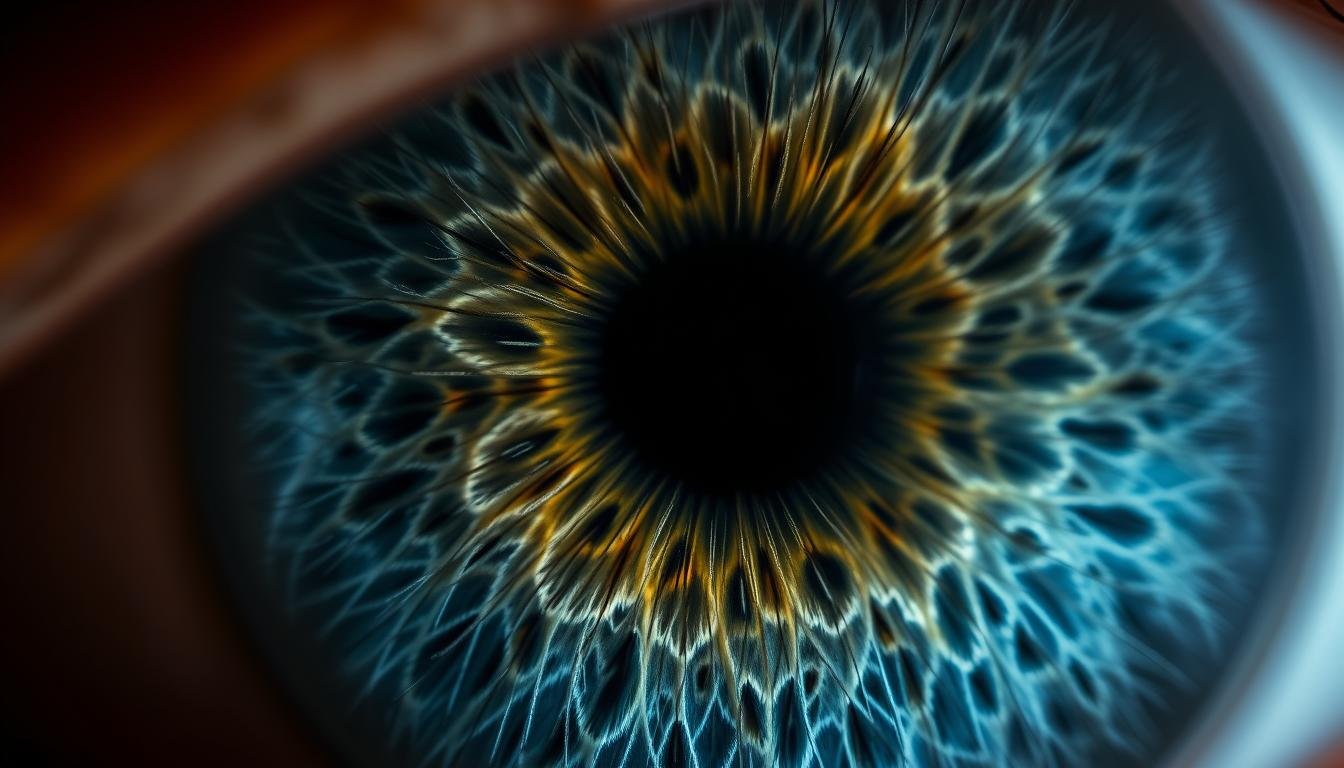
O que é iridologia?
Iridology is an alternative medicine practice that involves examining the patterns, colors, and other characteristics of the iris to evaluate a person’s overall health. Practitioners of iridology, known as iridologists, believe that each area of the iris corresponds to a specific organ or body system, and that changes in these areas can reflect changes in the health of the corresponding body parts.
Os intrincados padrões da íris humana que os iridologistas analisam para avaliação da saúde
The core premise of **iridologia** is that the iris serves as a “mapa” do corpo, com diferentes zonas correspondentes a diferentes órgãos e sistemas. De acordo com esta teoria, quando um órgão ou sistema sofre estresse, inflamação ou outros problemas de saúde, alterações correspondentes aparecem na íris. Essas alterações podem incluir manchas, linhas, descolorações ou alterações estruturais que um iridologista interpreta para avaliar seu estado de saúde.
Iridologists use specialized equipment such as magnifying glasses, cameras, and sometimes microscopes to examine the iris in detail. They then compare their observations with **iris charts** that map out which areas of the iris correspond to which body parts and systems.
The History of Iridology
Embora alguns proponentes afirmem que as formas de exame da íris remontam a civilizações antigas no Egito, na China e na Índia, os modernos iridologia tal como a conhecemos hoje começou a tomar forma no século XIX.

Ignaz von Peczely, o médico húngaro considerado o pai da iridologia moderna
The foundations of modern iridology are often attributed to Ignaz von Peczely, a Hungarian physician in the 1800s. According to popular accounts, as a child, von Peczely noticed a dark streak in the iris of an owl whose leg he had accidentally broken. This observation sparked his curiosity, and he later developed the theory that changes in the iris could reflect injuries or diseases in corresponding parts of the body.
Em 1881, Von Peczely publicou seu primeiro livro sobre o assunto, “Descobertas no campo da ciência e medicina naturais: instrução no estudo do diagnóstico do olho,” which included the first known **iris chart** mapping different areas of the iris to various body parts.
Another significant figure in the development of iridology was Nils Liljequist, a Swedish homeopath who independently developed similar theories around the same time. Liljequist claimed to have observed changes in his own iris after taking medications like quinine and iodine, which led him to create his own iris charts.

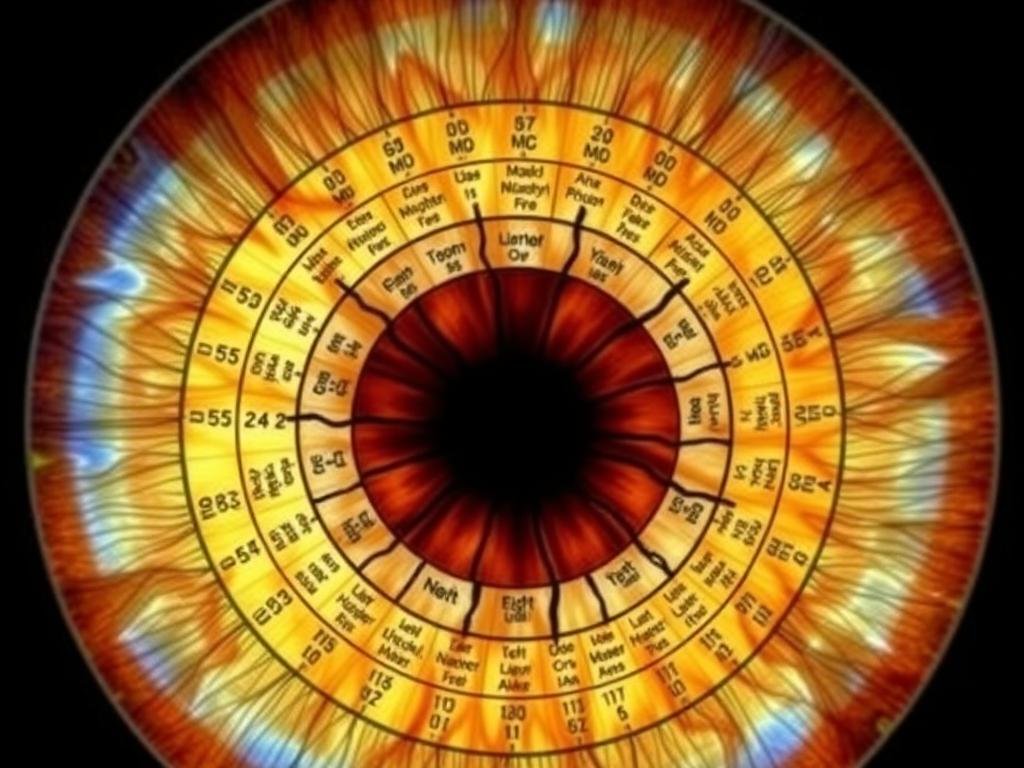
Gráfico iridológico de Bernard Jensen mapeando órgãos do corpo para regiões específicas da íris
In the United States, iridology gained popularity in the 1950s through the work of Bernard Jensen, an American chiropractor who developed his own method of iris analysis and created detailed iris charts that are still used by many practitioners today. Jensen’s work helped popularize iridology as part of the broader natural health movement in America.
How Iridologists Analyze the Iris
Iridology practitioners use specific methodologies to examine and interpret the features of the iris. Understanding these techniques provides insight into how this practice is conducted.
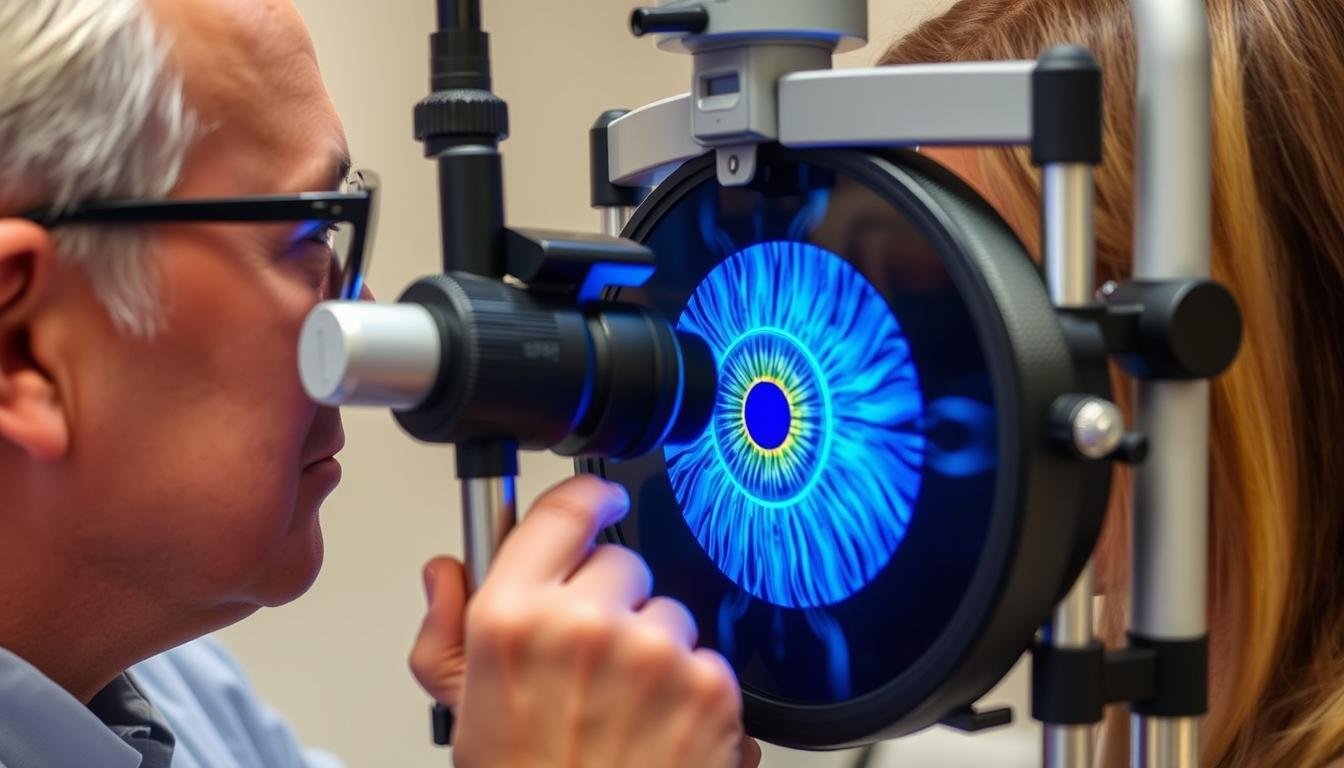
Um iridologista realizando um exame usando equipamento especializado
Ferramentas e técnicas de exame
Os iridologistas modernos normalmente usam várias ferramentas para realizar seus exames:
- Caneta ou lanterna para iluminar a íris
- Lupa ou lupa para uma inspeção mais detalhada
- Câmeras digitais com lentes macro para fotografia detalhada
- Câmeras de íris especializadas projetadas especificamente para iridologia
- Software de computador para análise de fotografias de íris
During an examination, the iridologist first takes a detailed look at both irises, noting their overall color, structure, and any visible markings. They may take photographs to analyze later or use computer software that helps identify patterns.
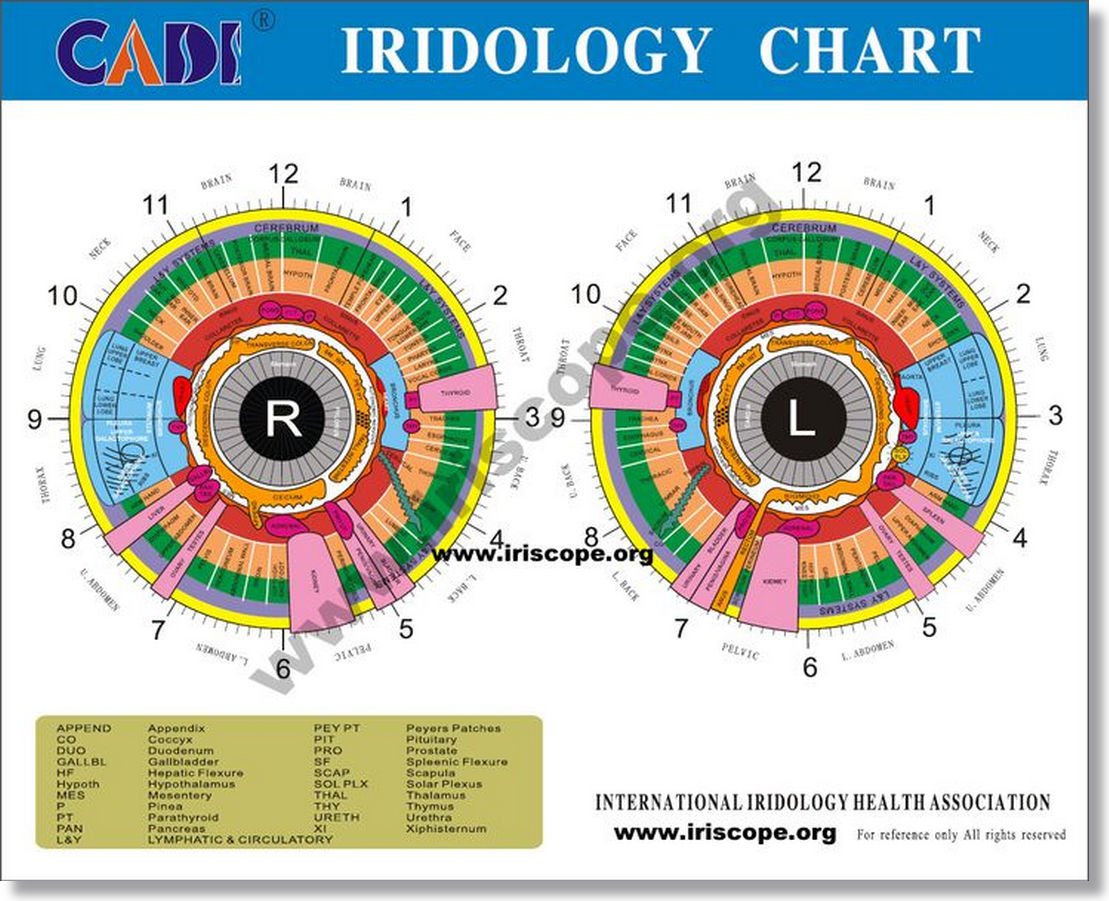



Detailed iridology chart showing the 60 zones that correspond to different body systems
Interpretation Using Iris Charts
The cornerstone of iridology practice is the **iris chart**, which divides the iris into approximately 60 zones, each corresponding to a different part of the human body. These charts typically follow a few key principles:
- A íris direita geralmente corresponde ao lado direito do corpo
- A íris esquerda geralmente corresponde ao lado esquerdo do corpo
- A íris é dividida em zonas concêntricas que representam diferentes sistemas corporais
- O gráfico é frequentemente organizado como um mostrador de relógio, com órgãos e sistemas posicionados em posições específicas. “horas”
Iridologists look for various features in the iris that they believe indicate health issues:
Mudanças de cor
Variations in pigmentation or discoloration in specific zones may indicate inflammation, toxicity, or other issues in the corresponding body part.
Structural Features
Fibers, rings, and other structural elements in the iris are analyzed for their pattern, density, and arrangement.
Lesions and Markings
Spots, dots, lines, or other markings are interpreted as signs of specific health conditions or weaknesses.
Pupil Characteristics
While not part of the iris itself, some iridologists also examine the pupil’s shape, size, and reaction to light as part of their assessment.
Health Conditions Iridologists Claim to Detect
Practitioners of iridology claim they can identify a wide range of health conditions and predispositions by examining the iris. While these claims lack scientific validation, understanding what iridologists believe they can detect helps explain the practice’s appeal to some individuals.



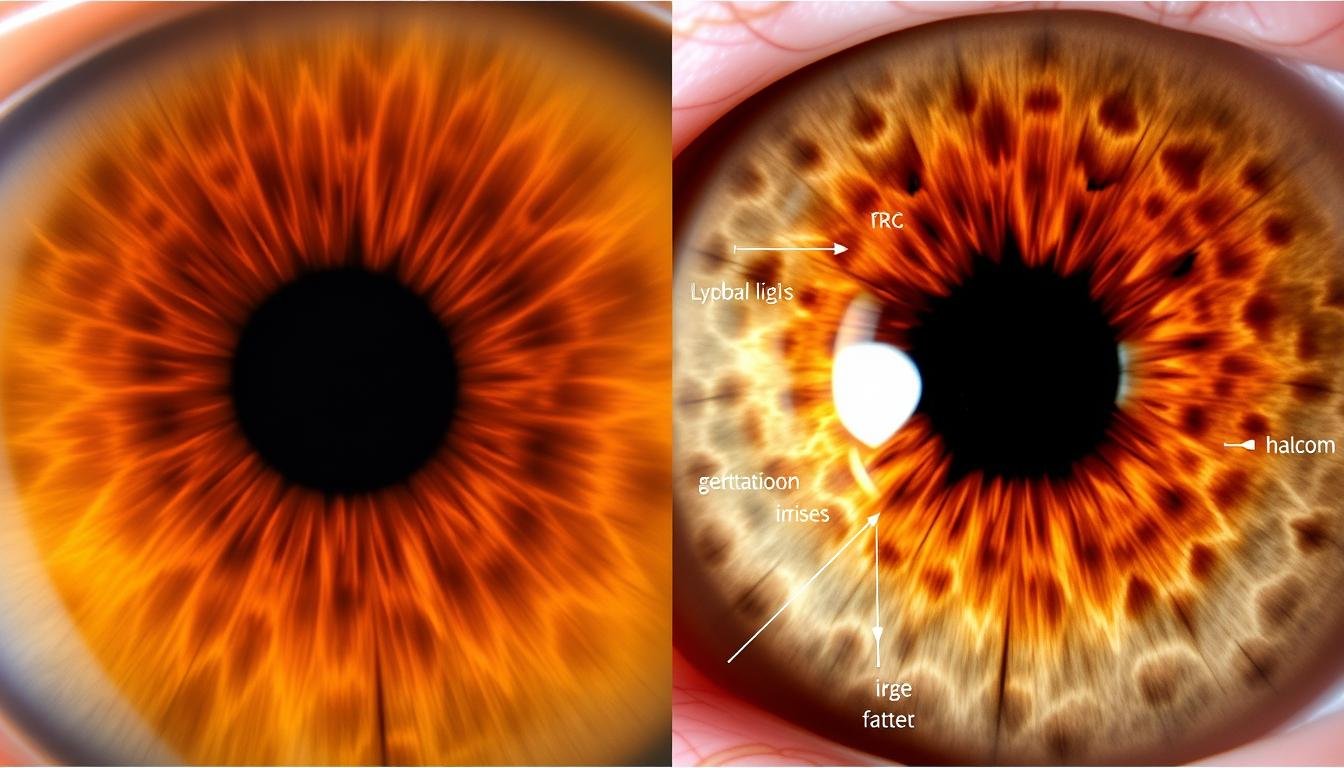
Comparação de padrões de íris mostrando o que os iridologistas interpretam como indicadores do estado de saúde
Common Health Issues Supposedly Revealed Through Iridology
Função do órgão
- Disfunção hepática
- Estresse renal
- Distúrbios digestivos
- Fraquezas cardíacas
- Condições pulmonares
Condições Sistêmicas
- Inflamação em todo o corpo
- Acúmulo de toxinas
- Congestão do sistema linfático
- Problemas circulatórios
- Desequilíbrios hormonais
Indicadores Gerais de Saúde
- Deficiências nutricionais
- Níveis de estresse e localização
- Predisposições genéticas
- Lesões ou traumas passados
- Força constitucional geral
Interested in Learning More About Your Eye Health?
While iridology remains controversial, comprehensive eye exams by qualified professionals can detect many health conditions. Consider scheduling an appointment with an optometrist or ophthalmologist for proper eye care.
Find an Eye Care Professional Near You
Os iridologistas também afirmam que podem detectar problemas de saúde antes que os sintomas apareçam, sugerindo que as alterações na íris precedem o desenvolvimento dos sintomas físicos. Esta afirmação de detecção precoce é particularmente atraente para aqueles interessados em abordagens preventivas de saúde.
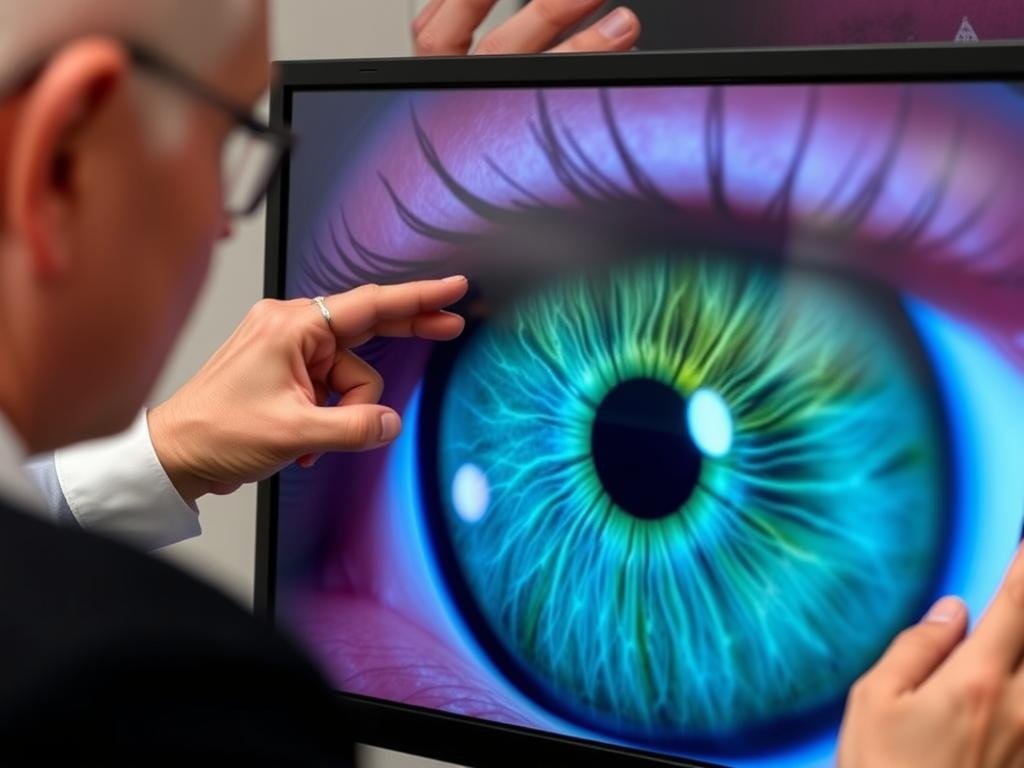
Um iridologista identificando marcas específicas da íris e explicando sua interpretação
É importante notar que, embora os iridologistas façam estas afirmações, a capacidade de diagnosticar condições de saúde específicas através do exame da íris não foi validada pela investigação científica, como exploraremos na próxima secção.
Perspectiva científica sobre iridologia
Despite its long history and continued practice, iridology has been subject to scientific scrutiny, with most research failing to support its fundamental claims. Understanding the scientific perspective helps provide a balanced view of this alternative practice.
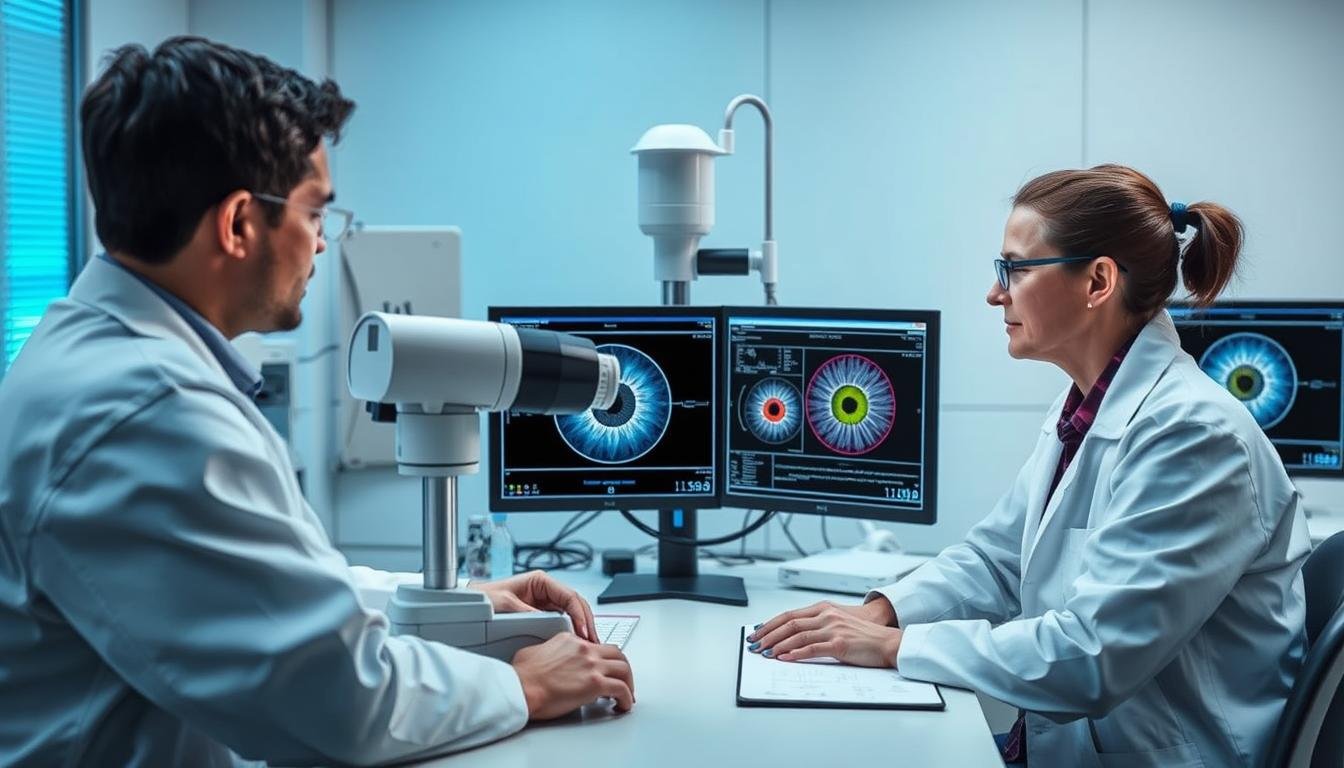
Pesquisa científica examinando a validade das afirmações da iridologia
Estudos de pesquisa e suas descobertas
Several controlled studies have investigated the diagnostic accuracy of iridology:
- Uma revisão sistemática publicada em 1999 na revista Complemento de pesquisa examinou quatro estudos de caso-controle e concluiu que a eficácia da iridologia não era apoiada por avaliações científicas.
- Um estudo publicado em 2000 no Arquivos de Oftalmologia descobriram que os iridologistas não conseguiam detectar doenças renais de forma consistente através do exame da íris.
- Pesquisa publicada no Revista de Medicina Alternativa e Complementar não conseguiram encontrar evidências de que os iridologistas pudessem diagnosticar com precisão doenças da vesícula biliar examinando a íris.
Most scientific studies have concluded that iridology has shown little to no diagnostic value when tested under controlled conditions. Researchers have consistently found that iridologists cannot reliably identify people with specific diseases by examining their irises.
Perspectiva da Comunidade Médica
The mainstream medical community generally does not support iridology as a diagnostic tool for several reasons:
Preocupações Científicas Sobre Iridologia
- Falta de conexão anatômica entre a íris e a maioria dos órgãos do corpo
- Ausência de um mecanismo fisiológico para explicar como as condições dos órgãos internos afetariam a aparência da íris
- Resultados inconsistentes quando vários iridologistas examinam o mesmo paciente
- Falha em demonstrar precisão diagnóstica em estudos controlados
- A estrutura da íris é amplamente determinada pela genética e permanece relativamente estável ao longo da vida
Medical professionals express concern that reliance on iridology for diagnosis could potentially lead to delayed treatment of serious conditions if patients forego conventional medical diagnosis in favor of iridology readings.
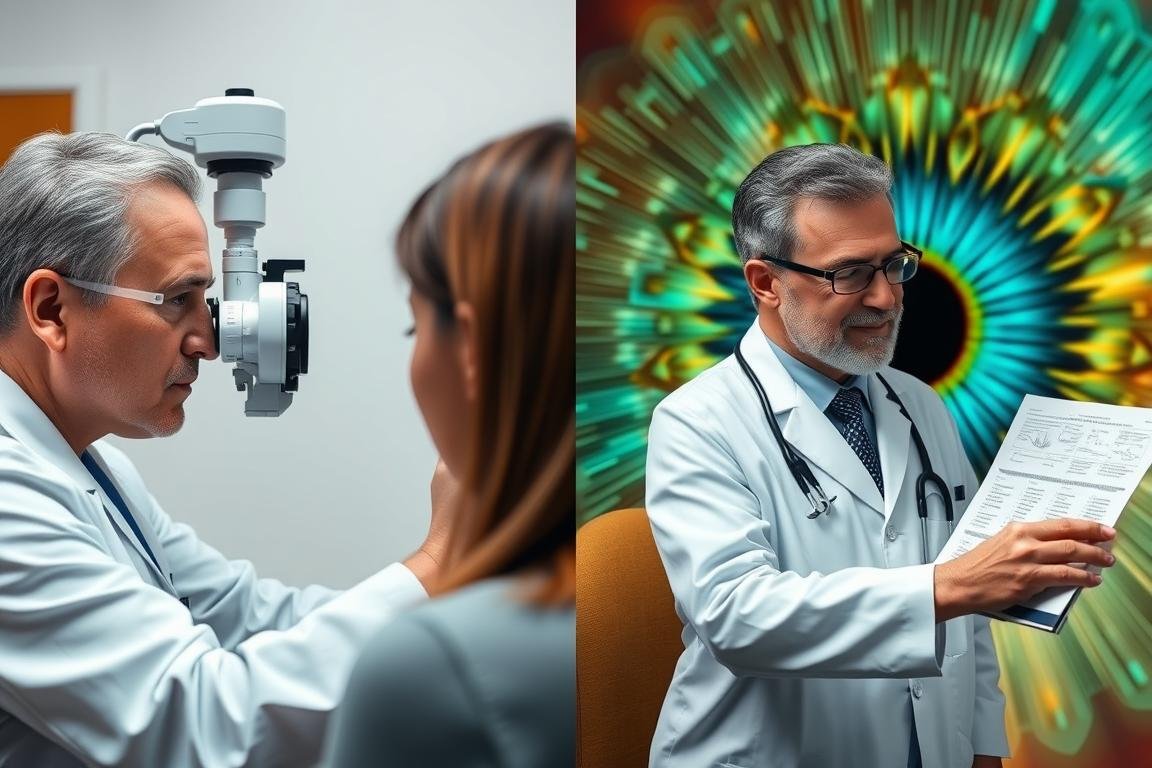
Comparação entre exame oftalmológico convencional e avaliação iridológica
While the scientific consensus does not support iridology as a diagnostic method, some researchers suggest that further studies with improved methodology could be valuable to fully evaluate any potential correlations between iris features and health conditions.
Modern Applications of Iridology
Despite the lack of scientific validation, iridology continues to be practiced in various parts of the world, particularly within holistic and alternative health communities. Understanding its contemporary applications provides insight into why some people still seek out this practice.
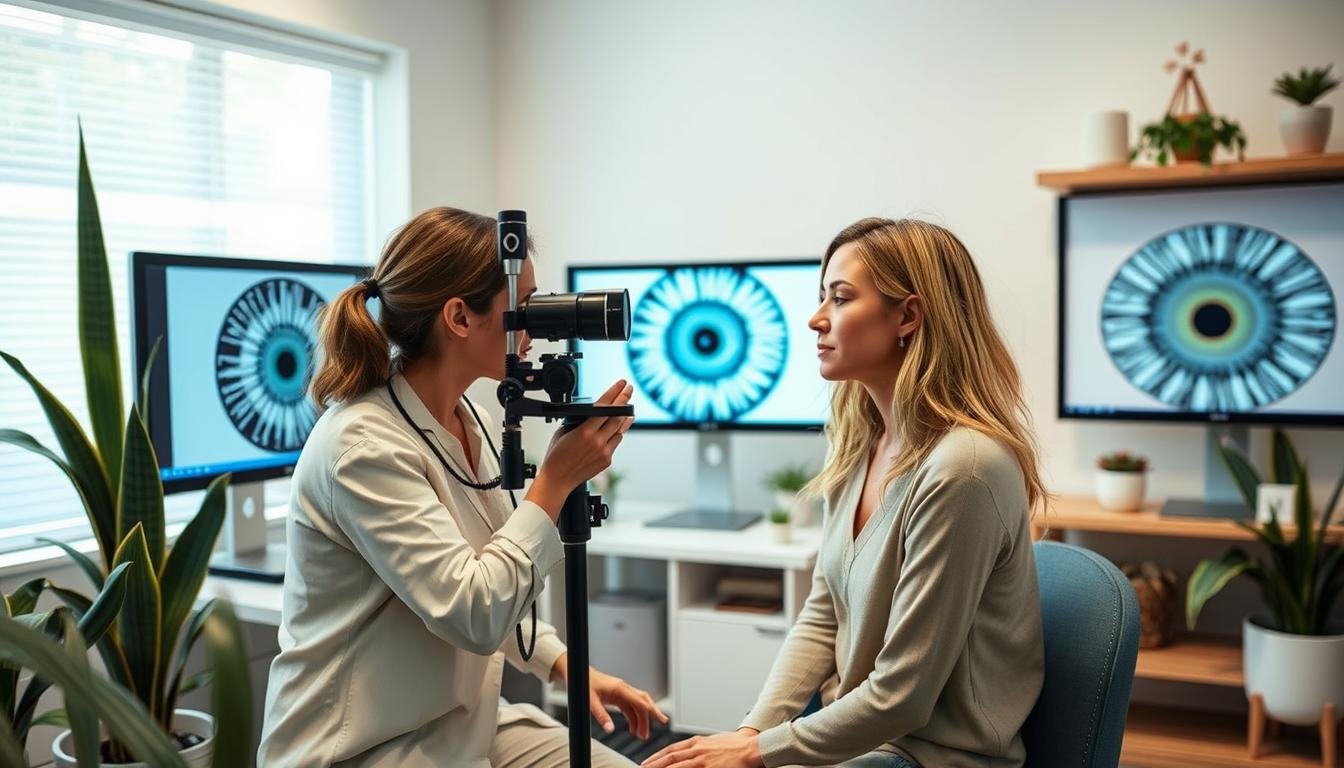
Prática moderna de iridologia em um ambiente de saúde holístico contemporâneo
Integração com Práticas Holísticas de Saúde
In today’s wellness landscape, iridology is often integrated with other alternative and complementary health approaches:
- Como parte das avaliações naturopatas para orientar as recomendações de tratamento
- Em conjunto com aconselhamento nutricional para sugerir modificações dietéticas
- Juntamente com a fitoterapia para informar as prescrições fitoterápicas
- Dentro de avaliações holísticas de saúde que incluem vários métodos de avaliação
- Como ferramenta complementar em algumas práticas de medicina integrativa
Practitioners who use iridology today often view it as one tool among many for assessing overall health patterns rather than as a definitive diagnostic method for specific diseases.
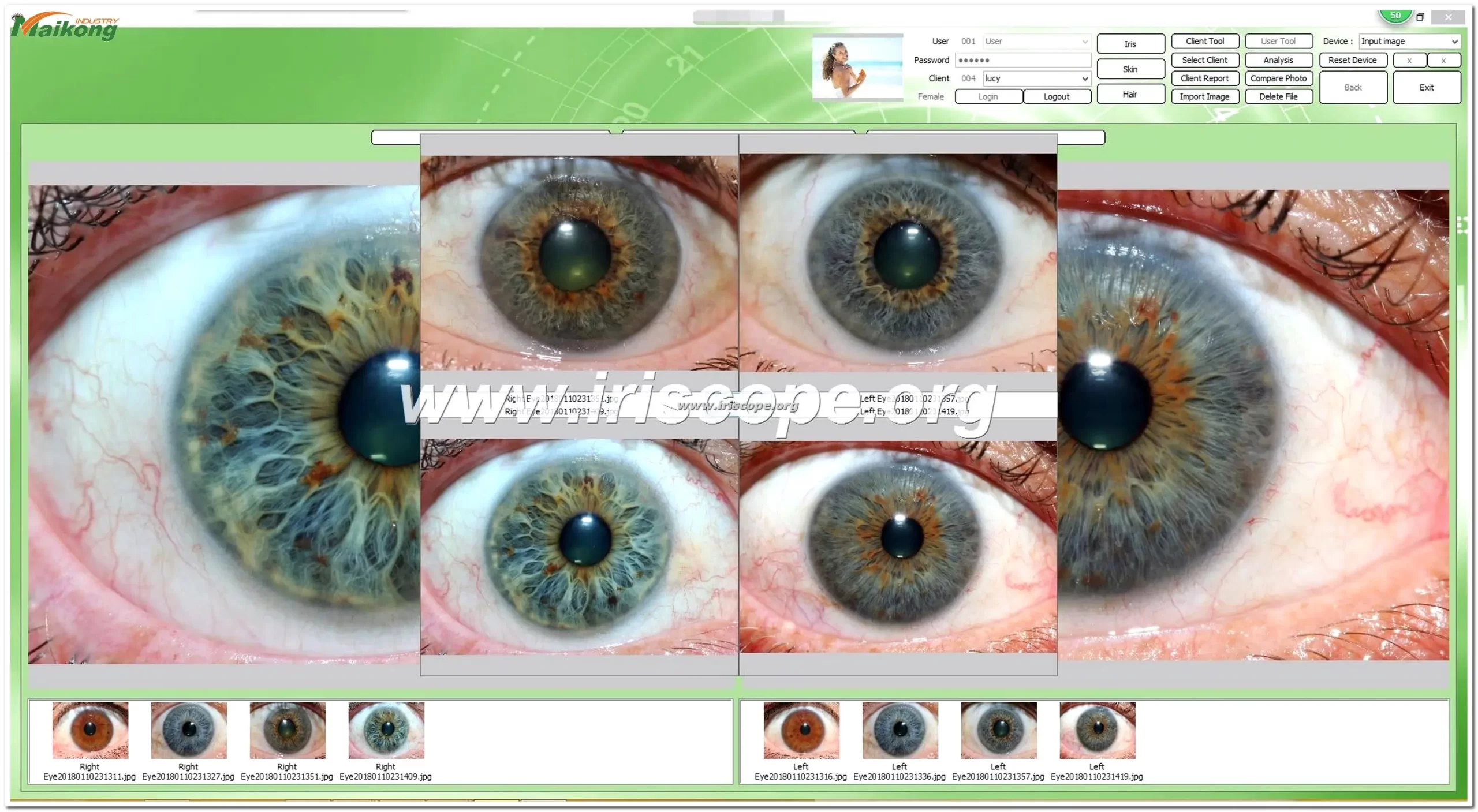

Tecnologia digital moderna usada na prática contemporânea da iridologia
Avanços tecnológicos
Technology has influenced how iridology is practiced in the 21st century:
- Câmeras digitais de alta resolução capturam imagens detalhadas da íris
- Programas de software especializados analisam padrões e marcações da íris
- Plataformas online oferecem consultas remotas de iridologia
- Aplicativos móveis permitem análise preliminar da íris
These technological advancements have made iridology more accessible but haven’t necessarily increased its diagnostic accuracy according to scientific standards.
Considering Alternative Health Approaches?
If you’re interested in holistic health assessments, remember to maintain a balanced approach. Always consult with qualified healthcare providers for proper diagnosis and treatment of health conditions.
Schedule a Comprehensive Health Assessment
Conclusion: The Place of Iridology in Health Practices
Iridology presents an intriguing concept—that the iris might serve as a window into our overall health. While the practice has a long history and continues to attract interest, particularly in holistic health communities, it’s important to approach it with an informed perspective.

Uma abordagem equilibrada à saúde ocular combina cuidados convencionais com consciência holística
The scientific evidence does not currently support iridology as a reliable diagnostic method. Multiple controlled studies have failed to demonstrate that iridologists can consistently identify specific health conditions through iris examination. The medical community generally views iridology as lacking scientific foundation and potentially problematic if it leads people to delay seeking conventional medical care for serious conditions.
However, for those interested in holistic approaches to health, iridology might be viewed as one of many tools for general health assessment rather than as a definitive diagnostic technique. Some find value in the holistic perspective it offers, even if specific diagnostic claims remain unproven.
If you’re curious about iridology, consider these balanced recommendations:
- Approach iridology as a complementary tool rather than a replacement for conventional medical diagnosis
- Mantenha check-ups regulares com profissionais de saúde qualificados
- Seja cético em relação a diagnósticos de saúde definitivos feitos exclusivamente através do exame da íris
- Pesquise as qualificações e a abordagem de qualquer profissional de iridologia que você considere consultar
- Considere o valor potencial da conversa holística sobre saúde que pode surgir de uma sessão de iridologia, mesmo que alegações diagnósticas específicas sejam vistas de forma crítica
Ultimately, your health deserves a comprehensive approach that considers evidence-based practices while remaining open to the potential insights that various perspectives might offer. The eyes are indeed remarkable organs—worthy of care, protection, and perhaps even a bit of wonder—regardless of one’s view on iridology.
Perguntas freqüentes sobre iridologia
A iridologia é o mesmo que um exame oftalmológico regular?
No, iridology is fundamentally different from a conventional eye examination. A regular eye exam performed by an optometrist or ophthalmologist focuses on assessing vision and detecting eye diseases such as glaucoma, cataracts, or macular degeneration. These professionals use standardized, scientifically validated methods to evaluate eye health and vision.
Iridology, in contrast, involves examining the iris to allegedly determine the health status of other body organs and systems—not to diagnose eye conditions themselves. While a conventional eye exam has proven diagnostic value and is an essential part of healthcare, iridology lacks scientific validation for its claims about diagnosing non-ocular health conditions.
A iridologia pode detectar doenças graves como o câncer?
There is no scientific evidence supporting the claim that iridology can detect cancer or other serious diseases. Multiple controlled studies have failed to demonstrate that iridologists can reliably identify specific diseases through iris examination.
For serious conditions like cancer, it’s crucial to rely on evidence-based medical diagnostic methods such as imaging studies, biopsies, blood tests, and physical examinations performed by qualified healthcare professionals. Delaying conventional medical diagnosis and treatment while relying on iridology could potentially lead to worse health outcomes for serious conditions.
Quais qualificações os iridologistas normalmente possuem?
The qualifications of iridologists vary widely as there is no standardized, universally recognized certification or licensing specifically for iridology in most countries. Some practitioners may have completed courses or certification programs in iridology offered by various schools or organizations dedicated to alternative medicine. These programs can range from brief weekend courses to more extensive training programs.
Some iridologists may also be licensed healthcare practitioners such as naturopathic doctors, chiropractors, or acupuncturists who have added iridology to their practice. Others may have no formal healthcare training at all. When considering consulting an iridologist, it’s advisable to inquire about their specific training, approach, and whether they recommend iridology as a complement to, rather than a replacement for, conventional medical care.

































